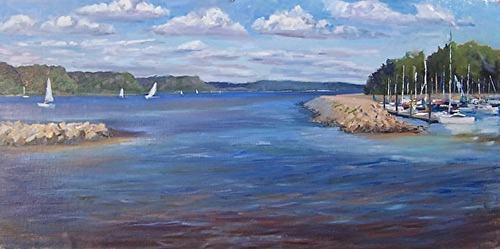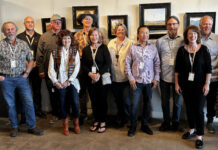– Bob Bahr reporting, Editor PleinAir Today –
Bob Matheson paints big on location, and he nearly completes it in one session. What’s his approach?
Lead Image: “Stockholm Overlook,” by Bob Matheson, 2016, oil, 30 x 48 in.
“The recent one I did, ‘Stockholm Overlook,’ was the largest outdoor painting I have done in one shot,” Matheson says. The Minneapolis painter went through the basics of his process with PleinAir Today so readers can get a sense of how he scales up for big plein air paintings.
“First I choose a scene with three to five big shapes, including the sky,” Matheson says. “Next I use a big brush, a house or hardware cheap one, two inches or wider. I draw in the outline of the big shapes and the design and start a transparent lay-in using value and color to block it in as quickly as possible. If corrections are needed, it is easy to wipe back to the white canvas if you keep it transparent as long as you can. This takes me 15 minutes to an hour or two, depending on the scene.
“From there I treat it like any other painting, working from back to front and from dark to light, using a big brush, maybe size 12 or 14. I use it as long as I can, until I have to go smaller, down to a size 10, 8, or even 6. Essentially, I start with a shovel and finish with a spoon! Sometimes the whole painting can be done with a couple sizes of brushes.”

Matheson continues, “I usually try to lock in the light effect that I want as soon as possible. Once that is done I can paint away without chasing the light. I stand, and walk back and forth 10 feet, looking at both the painting and the scene to keep it going. After a couple of hours, it should look like the scene from 20 feet away or so. At this point I start to go into the big shapes, adding details and color, working clockwise to keep the big look. After another hour or so, it should really look like a painting from 10 feet, and then it is finishing up, just like any other size.”
He says, “I usually spend four to six hours in the field, and maybe an hour or so in the studio to finish. By painting big, you get so involved, the time flies by! It is so rewarding when it works. Granted, all don’t work. But by using big shapes and big brushes, you really can do them fast. When you go back to a smaller size, you will be amazed at how you can work. I find it easier to paint big than to paint small, and it is much harder to get too tight in the big ones. I usually do one-shot paintings, but this method will work for multiple ones as well.
“So I guess to sum it up: big canvas, 24 x 30 and up. Big shapes. Big brushes. It will give you a lot of fun and look great on the wall.”




